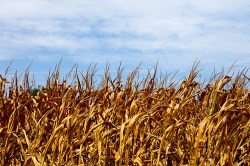
Photo by Tom Woodward.
Things are looking bleak for corn farmers in the Midwest. Drought conditions and above-average temperatures are likely to continue for some time and now even soybeans — corn’s sister commodity — are succumbing to the weather. The economic implications for the entire Midwest — and not just farmers — are dire.
Not that this is entirely unexpected. Experts have been warning commodity farmers for years that a changing climate will lead to exactly these kinds of devastating conditions in the nation’s heartland.
And, yes, I agree with David Roberts, who says it’s time to dispense with “climate disclaimers,” i.e. the “well, gee, we don’t really know” qualifications about the relationship between climate change and these kinds of weather events. After all, as Grist reported recently, the government’s National Climatic Data Center calculated that if the climate weren’t warming, we wouldn’t expect to see another period as hot as the last 13 months have been until the year 124,652. Does anyone really believe that we’re experiencing “100,000-year” warmth? Me neither.
There’s also the effect the heat and drought are having on food prices; Bloomberg Businessweek reports that prices on grocery store shelves are already on the rise:
In May, retail prices of boneless hams, ground beef and cheese in the U.S. were close to all-time highs set earlier this year, while chicken breast jumped more than 12 percent during the first five months of the year, government data show.
“When people look at rising prices for hamburger, butter, eggs and other protein sources from higher corn costs, that’s when more money ends up in the food basket,” said Minneapolis- based Michael Swanson, a senior agricultural economist at Wells Fargo & Co., the biggest U.S. farm lender. “We were hoping for a break, and we aren’t going to get it.”
But it’s also worth considering what’s going on in the Midwest in light of today’s markup of the House Agriculture Committee’s draft of the new farm bill. [Update: The House Agriculture Committee approved the bill on July 12. There is still no date set for a vote by the full House.] While I reported on the outrageous cuts to food stamps in the House version last week, I didn’t get a chance to review the equally outrageous, effectively unrestricted expansion of crop insurance included in the bill. As the Environmental Working Group summed it up, the committee draft “would give unlimited taxpayer dollars to farmers who are already making record profits and less support to hungry kids who depend on federal assistance for food.”
As it is, the payouts to farmers for the likely crop losses will be enormous. In fact, claims are already starting to roll in. In commodity crop states like Iowa, upwards of 90 percent of the corn and soy crops are covered by insurance — with an additional federal agricultural disaster relief program backstopping the big losses from these kinds of weather events.
On the one hand, you could argue that this kind of thing is exactly what these programs were designed to do — protect farmers from natural disasters. But as climate scientists are (finally) loudly proclaiming, the climate future is now. Or, as an atmospheric scientist put it to the Associated Press in reference to this summer’s extreme weather, “This is what global warming looks like.”
In other words, the only groups acting like this weather is a fluke are the U.S. Department of Agriculture (USDA), insurance companies, and the owners of big farms. Because even after this year’s losses and the attendant spike in grain prices (in fact, they’re already spiking), the system is designed to encourage farmers to plant as much or more of the same crops next year as they did this year, which already saw the largest planted acreage in over a half century. And thus are we set up for a repeat experience, whether it’s next year, the year after, or a few years down the road.
Tom Philpott at Mother Jones observed that for all Big Ag’s talk of technological solutions for managing extreme weather, research [PDF] shows that the most promising strategies come from organic practices, which focus on building soil health and resiliency.
As Philpott said, “a climate-ready agriculture system will not likely arrive gift-wrapped in the form of a silver-bullet technology from the ag-biotech industry,” but will come to pass because farmers finally turn their backs on the chemically intensive monocropping practices of modern industrial agriculture.
Skeptics can roll their eyes until they fall out of their heads. But it’s impossible to look at the parched fields of Iowa, Indiana, and Ohio with their drought-induced (two-feet-deep!) crevasses, watch the seemingly annual mega-heat waves roll across the plains, and maintain that it’s a good idea to pay out billions of dollars worth of insurance policies just so that farmers can try again next year.
Yet that’s exactly what the new farm bill will encourage commodity farmers to do. It’s understandable that individual farmers would want to chalk this up to a bad year and hope for better weather. But the USDA needs to recognize that the weather patterns which gave rise to the Corn (and Soy) Belt of the Midwest have permanently changed. And farming needs to change with them.
Persistent drought isn’t here to stay in the Midwest (though that is the future for the southwestern U.S. circa 2050) but extreme weather probably is. And it’s awfully hard to move agriculture in the right direction when the USDA — with the enthusiastic endorsement of farm-state representatives in the House and Senate — wants to throw billions upon billions of dollars at farmers to stay a failing course.



